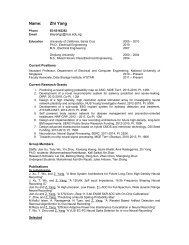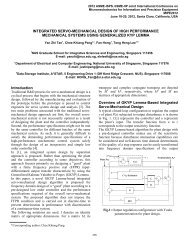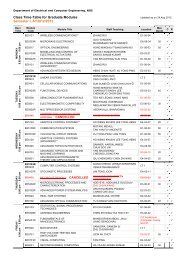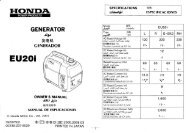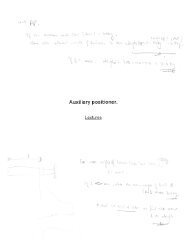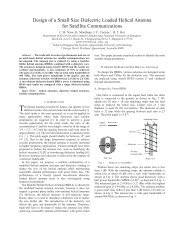Development and evolution of MOEMS technology in variable ...
Development and evolution of MOEMS technology in variable ...
Development and evolution of MOEMS technology in variable ...
You also want an ePaper? Increase the reach of your titles
YUMPU automatically turns print PDFs into web optimized ePapers that Google loves.
Lee <strong>and</strong> Yeh: <strong>Development</strong> <strong>and</strong> <strong>evolution</strong> <strong>of</strong> <strong>MOEMS</strong> <strong>technology</strong>…<br />
Fig. 13 VOA device comprises a planar-tilted mirror driven by a<br />
V-beam electrothermal actuator. a Schematic draw<strong>in</strong>g, b CCD<br />
image <strong>of</strong> the tilted mirror, spr<strong>in</strong>g, l<strong>in</strong>k beam, <strong>and</strong> electrothermal actuator<br />
<strong>of</strong> VOA device, c CCD image <strong>of</strong> the tilted mirror, spr<strong>in</strong>g, <strong>and</strong><br />
trenches for accommodat<strong>in</strong>g fibers, <strong>and</strong> d novel planar lightattenuation<br />
scheme is realized by us<strong>in</strong>g this tilted mirror with rotational<br />
<strong>and</strong> translational displacement.<br />
nism compris<strong>in</strong>g a tilted mirror driven by a V-beam electrothermal<br />
actuator via a l<strong>in</strong>k beam as shown <strong>in</strong> Figs. 13a<br />
<strong>and</strong> 13b. This electrothermally driven tilted mirror has<br />
static displacement with a motion trace, <strong>in</strong>clud<strong>in</strong>g rotational<br />
<strong>and</strong> translational movement as shown <strong>in</strong> Fig. 13c <strong>and</strong><br />
13d. 51 The rotational <strong>and</strong> translational misalignment <strong>of</strong> a<br />
reflected light spot toward the core <strong>of</strong> the output port fiber<br />
will lead to light attenuation. Thus the attenuation is controlled<br />
<strong>in</strong> terms <strong>of</strong> the position <strong>of</strong> the tilted mirror depend<strong>in</strong>g<br />
on driv<strong>in</strong>g dc voltage. This micromechanism granted a<br />
more efficient way <strong>of</strong> conduct<strong>in</strong>g the attenuation with respect<br />
to the other k<strong>in</strong>ds <strong>of</strong> planar VOAs. These devices<br />
achieved 30-dB attenuation under 7.5 dc V. The PDL was<br />
less than 0.1 dB with<strong>in</strong> the 30-dB attenuation region.<br />
7 Evolution <strong>in</strong> <strong>MOEMS</strong>-Based 3D<br />
Optical-Attenuation Approaches<br />
Comb<strong>in</strong><strong>in</strong>g optics <strong>and</strong> a tilted mirror or a rotational mirror,<br />
<strong>and</strong>/or an array <strong>of</strong> mirrors to be assembled <strong>in</strong> a 3-D<br />
configuration is also a key approach <strong>of</strong> mak<strong>in</strong>g MEMS<br />
VOA devices. Andersen et al. from Lucent Technology <strong>in</strong><br />
2000 reported a surface-micrmach<strong>in</strong>ed tilted mirror us<strong>in</strong>g a<br />
3-D attenuation scheme, 52 while Riza et al. from the University<br />
<strong>of</strong> Central Florida <strong>in</strong> 1999 reported a 3-D VOA<br />
us<strong>in</strong>g a DMD mirror array at Texas Instruments. 53 Rob<strong>in</strong>sen<br />
from Lucent Technology filed a U.S. patent <strong>in</strong> 1998<br />
regard<strong>in</strong>g this sort <strong>of</strong> idea, 54 i.e., the attenuated light is<br />
controlled by chang<strong>in</strong>g the tilted angle <strong>of</strong> said tilted mirror,<br />
or a portion <strong>of</strong> a mirror array <strong>in</strong> a digital manner. However,<br />
these early demonstrations only show moderate performance.<br />
In pr<strong>in</strong>ciple, we may prepare a large, s<strong>in</strong>glecrystall<strong>in</strong>e<br />
silicon rotational mirror by us<strong>in</strong>g the state-<strong>of</strong>the-art<br />
micromach<strong>in</strong><strong>in</strong>g technologies. 55 When rotational<br />
mirrors are deployed for 3-D VOA <strong>in</strong> conjunction with<br />
large micro-optics, such as dual-core collimators, etc., the<br />
result<strong>in</strong>g VOA device ga<strong>in</strong>s excellent data <strong>of</strong> return loss,<br />
PDL, <strong>and</strong> WDL under reasonable driv<strong>in</strong>g voltage, i.e.,<br />
small rotational angle. Toshiyoshi et al. at the University <strong>of</strong><br />
Tokyo have demonstrated a device <strong>in</strong> which the derived<br />
performance is very good <strong>in</strong> this sense, i.e., only 4.5 dc V<br />
can achieve 0.3 deg rotational angle <strong>and</strong> 40-dB attenuation<br />
range. 56–58<br />
Another type <strong>of</strong> 3-D VOA uses a grat<strong>in</strong>g structure, i.e.,<br />
the diffractive type <strong>of</strong> mechanism. 59 By modify<strong>in</strong>g the<br />
orig<strong>in</strong>al design <strong>in</strong>vented by Solgaard, Lightconnect proposed<br />
a revised design us<strong>in</strong>g a circularly symmetric membrane<br />
structure. 60,61 This novel 3-D VOA is known as the<br />
first Telcordia-qualified MEMS VOA device. This device<br />
shows excellent response time, i.e., 40 s, <strong>and</strong> dynamic<br />
attenuation range. We should also address the effort <strong>of</strong> digital<br />
VOA development. By us<strong>in</strong>g an array <strong>of</strong> digital mirrors,<br />
i.e., ma<strong>in</strong>ta<strong>in</strong><strong>in</strong>g at either the rest position or the tilted position<br />
with a fixed deflection angle, we may <strong>in</strong>dividually<br />
address bias to a column <strong>of</strong> mirrors or a s<strong>in</strong>gle mirror<br />
among said array. 62,63 The extended dynamic range <strong>of</strong> the<br />
attenuation curve is achieved up to 80 dB, 62 <strong>and</strong> the attenuation<br />
curve with good l<strong>in</strong>earity can be feasibly to be derived.<br />
8 Manufacturability <strong>and</strong> Reliability<br />
As we discussed <strong>in</strong> the <strong>in</strong>troduction, there is a dem<strong>and</strong> for<br />
apply<strong>in</strong>g MEMS-based VOAs <strong>in</strong> multiple-channel format<br />
so as to fulfill the requirement <strong>of</strong> reconfigurable <strong>and</strong> transparent<br />
add/drop functions at nodes <strong>of</strong> an optical network.<br />
To have a monolithically <strong>in</strong>tegrated MEMS VOA with multiple<br />
channels means that we need very good process control<br />
<strong>in</strong> micr<strong>of</strong>abrication. Us<strong>in</strong>g silicon DRIE to sculpt actuators<br />
<strong>and</strong> micromirrors from SOI substrates at the same<br />
time has been the most available micromach<strong>in</strong><strong>in</strong>g process<br />
for VOAs. Trenches for facilitat<strong>in</strong>g optical fiber alignment<br />
are formed <strong>in</strong> the same DRIE step via the same photolithography<br />
mask. Such alignment trenches make the assembly<br />
<strong>and</strong> packag<strong>in</strong>g work much easier. In view <strong>of</strong> such process<br />
control from the aspect <strong>of</strong> manufacturability, we have<br />
to study the nonuniformity characteristics <strong>of</strong> process<strong>in</strong>duced<br />
device performance distribution for key parameters.<br />
In 2005, Lee explored <strong>and</strong> characterized the performance<br />
<strong>of</strong> arrayed MEMS VOA devices <strong>of</strong> eight<br />
<strong>in</strong>dependently controlled channels, i.e., multichanneled<br />
VOA MVOA us<strong>in</strong>g <strong>in</strong>-l<strong>in</strong>e shutter type, reflective type, 64<br />
<strong>and</strong> retroreflective type. 65 The number <strong>of</strong> channels is potentially<br />
scaled up to 16. As shown <strong>in</strong> Fig. 14, experimental<br />
J. Micro/Nanolith. MEMS <strong>MOEMS</strong> 021003-10<br />
Apr–Jun 2008/Vol. 72




